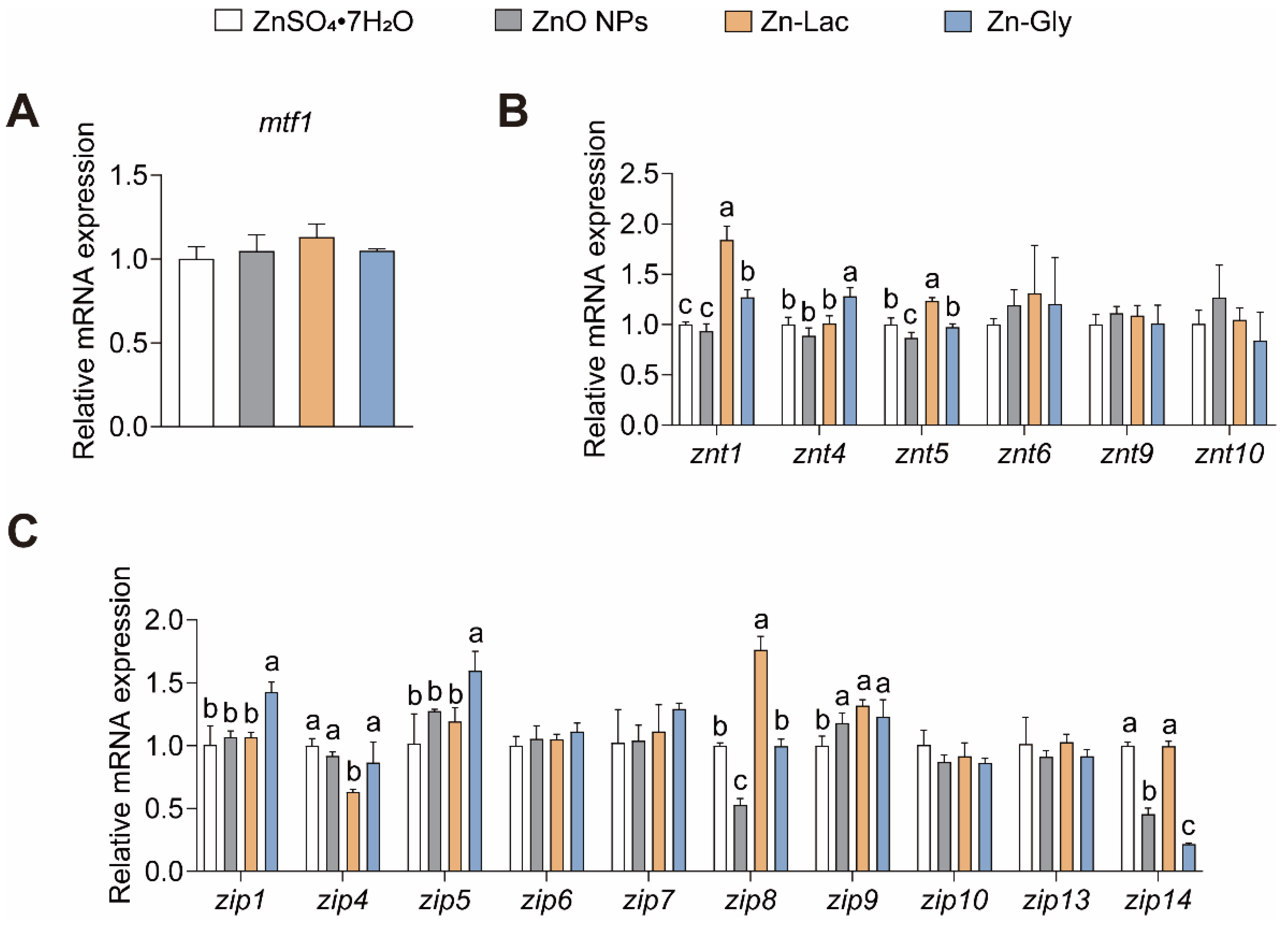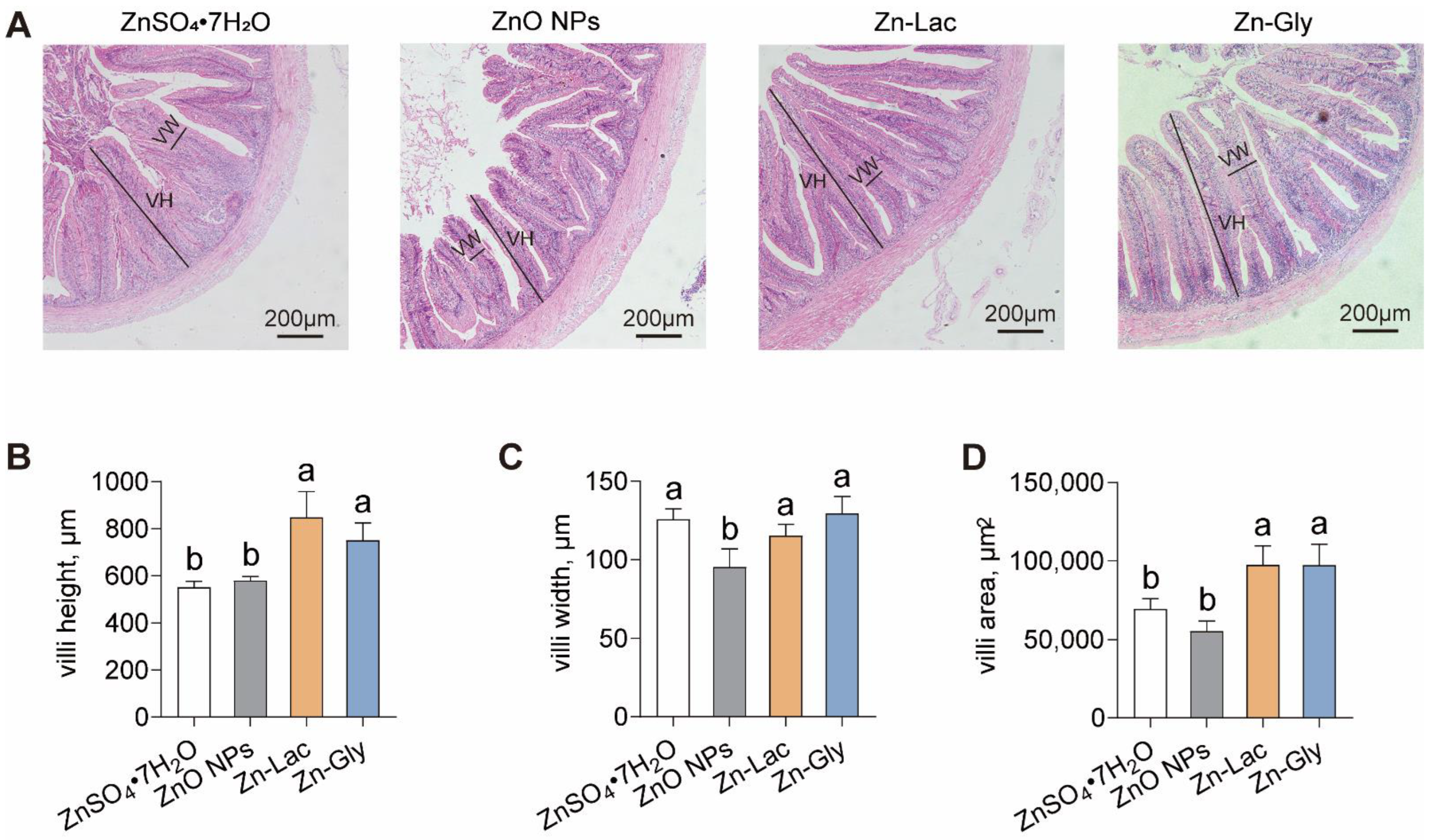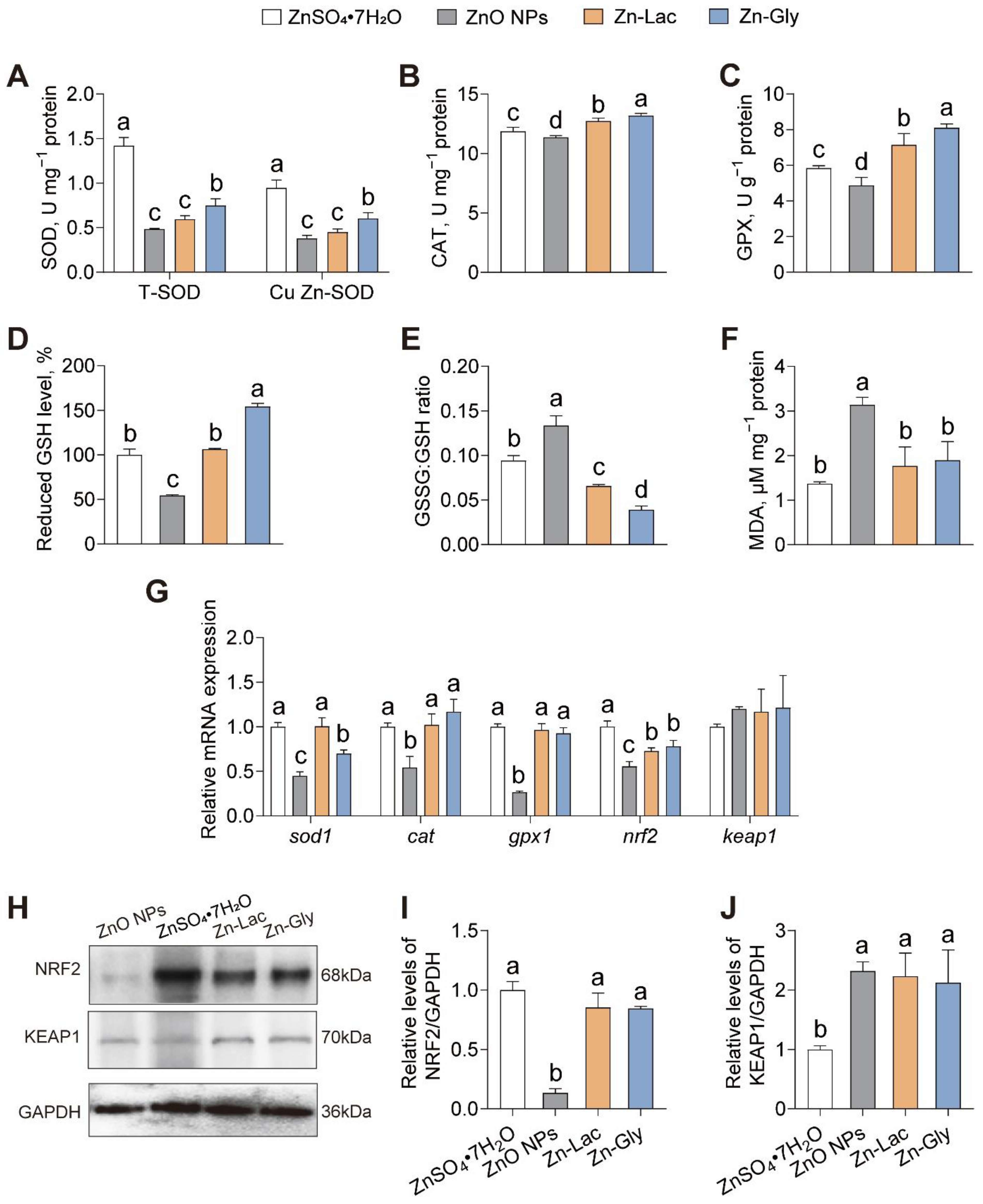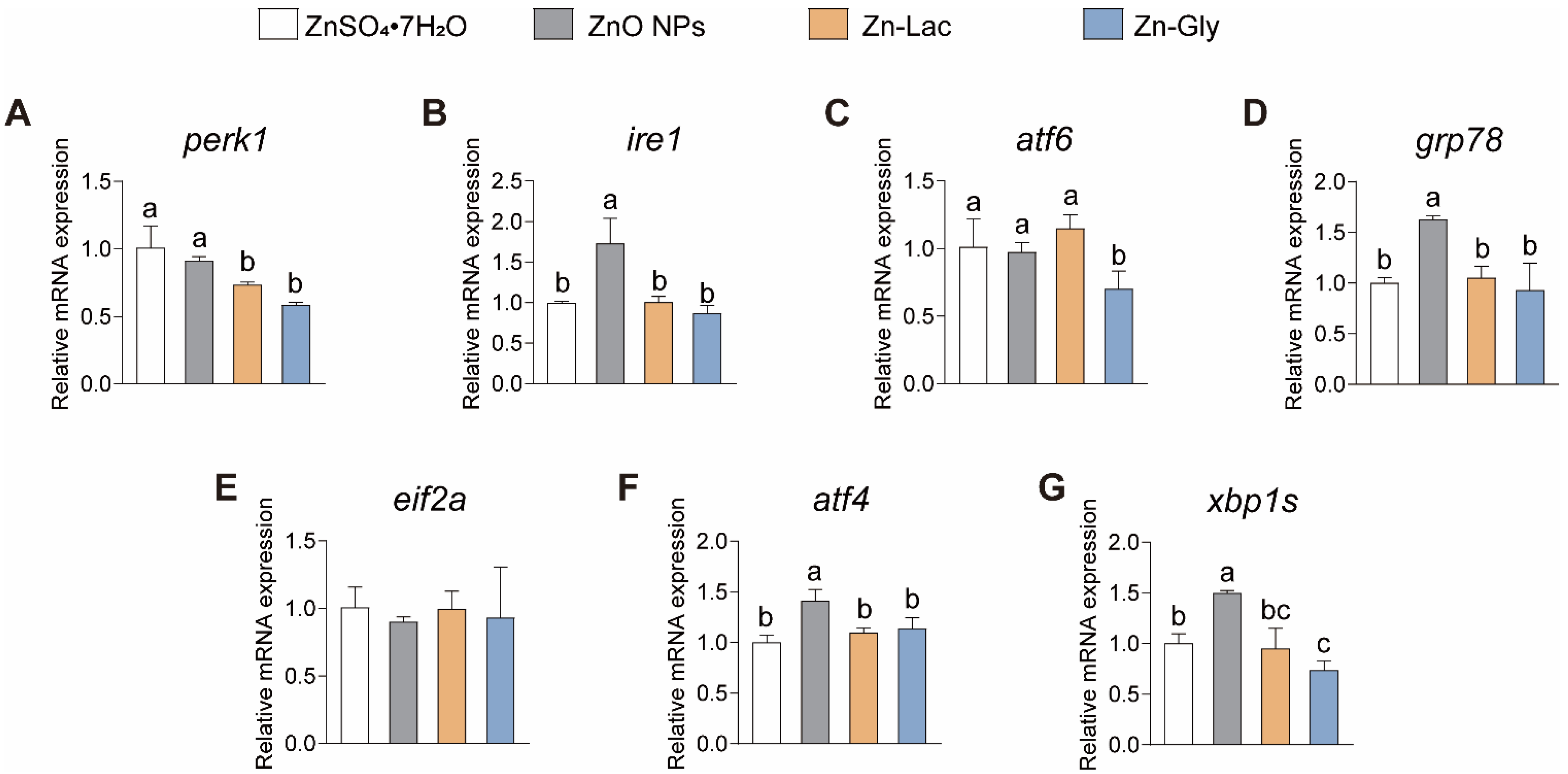Effects of Different Dietary Zinc (Zn) Sources on Growth Performance, Zn Metabolism, and Intestinal Health of Grass Carp
Abstract
:1. Introduction
2. Materials and Methods
2.1. Ethic Statement
2.2. Feed Formulation, Animals Feeding and Sampling
2.3. Sample Analysis
2.3.1. Hematoxylin and Eosin (H&E) Staining
2.3.2. Proximate Analysis of Nutrient Components and Zn Contents
2.3.3. Real-Time Quantitative PCR (qRT-PCR) Analysis
2.3.4. Immunoblot
2.3.5. Measurement of Antioxidant Capacity
2.4. Statistic Analysis
3. Results
3.1. Growth Performance
3.2. Intestinal Zn Level and mRNA Abundance of Zn Transporters
3.3. Histological Assessment of Intestine
3.4. Indices of Antioxidant Capacity
3.5. mRNA Expression of Gens Related to ER Stress
3.6. mRNA Expression of Genes Related to Tight Junctions
3.7. The Principal Component Analysis (PCA)
4. Discussion
5. Conclusions
Supplementary Materials
Author Contributions
Funding
Institutional Review Board Statement
Informed Consent Statement
Data Availability Statement
Conflicts of Interest
Abbreviations
References
- Choi, S.; Liu, X.; Pan, Z. Zinc deficiency and cellular oxidative stress: Prognostic implications in cardiovascular diseases. Acta. Pharmacol. Sin. 2018, 39, 1120–1132. [Google Scholar] [CrossRef] [PubMed]
- Kambe, T.; Tsuji, T.; Hashimoto, A.; Itsumura, N. The physiological, biochemical, and molecular roles of zinc transporters in zinc homeostasis and metabolism. Physiol. Rev. 2015, 95, 749–784. [Google Scholar] [CrossRef]
- Maret, W. The redox biology of redox-inert zinc ions. Free Radic. Biol. Med. 2019, 134, 311–326. [Google Scholar] [CrossRef] [PubMed]
- Haase, H.; Rink, L. Functional significance of zinc-related signaling pathways in immune cells. Annu. Rev. Nutr. 2009, 29, 133–152. [Google Scholar] [CrossRef]
- Chen, G.H.; Hogstrand, C.; Luo, Z.; Zhang, D.G.; Ling, S.C.; Wu, K. Dietary zinc addition influenced zinc and lipid deposition in the fore- and mid-intestine of juvenile yellow catfish Pelteobagrus fulvidraco. Br. J. Nutr. 2017, 118, 570–579. [Google Scholar] [CrossRef] [PubMed]
- Chen, G.H.; Song, C.C.; Zhao, T.; Hogstrand, C.; Wei, X.L.; Lv, W.H.; Song, Y.F.; Luo, Z. Mitochondria-dependent oxidative stress mediates ZnO Nanoparticle (ZnO NP)-induced mitophagy and lipotoxicity in freshwater teleost fish. Environ. Sci. Technol. 2022, 56, 2407–2420. [Google Scholar] [CrossRef] [PubMed]
- Meiler, K.A.; Kumar, V. Organic and inorganic zinc in the diet of a commercial strain of diploid and triploid rainbow trout (Oncorhynchus mykiss): Effects on performance and mineral retention. Aquaculture 2021, 545, 737126. [Google Scholar] [CrossRef]
- Kumar, N.; Krishnani, K.K.; Kumar, P.; Jha, A.K.; Gupta, S.K.; Singh, N.P. Dietary zinc promotes immuno-biochemical plasticity and protects fish against multiple stresses. Fish Shellfish Immunol. 2017, 62, 184–194. [Google Scholar] [CrossRef]
- Liang, X.F.; Cao, C.Y.; Chen, P.; Bharadwaj, A.S.; Wu, X.F.; Gu, X.; Tao, Q.; Xue, M. Effects of dietary zinc sources and levels on growth performance, tissue zinc retention and antioxidant response of juvenile common carp (Cyprinus carpio var. Jian) fed diets containing phytic acid. Aquacult. Nutr. 2020, 26, 410–421. [Google Scholar] [CrossRef]
- Ling, S.C.; Zhuo, M.Q.; Zhang, D.G.; Cui, H.Y.; Luo, Z. Nano-Zn increased Zn accumulation and triglyceride content by up-regulating lipogenesis in freshwater teleost, yellow catfish Pelteobagrus fulvidraco. Int. J. Mol. Sci. 2020, 21, 1615. [Google Scholar] [CrossRef]
- Wu, K.; Chen, G.H.; Hogstrand, C.; Ling, S.C.; Wu, L.X.; Luo, Z. Methionine-chelated Zn promotes anabolism by integrating mTOR signal and autophagy pathway in juvenile yellow catfish. J. Trace Elem. Med. Biol. 2021, 65, 126732. [Google Scholar] [CrossRef] [PubMed]
- Wu, S.E.; Hashimoto-Hill, S.; Woo, V.; Eshleman, E.M.; Whitt, J.; Engleman, L.; Karns, R.; Denson, L.A.; Haslam, D.B.; Alenghat, T. Microbiota-derived metabolite promotes HDAC3 activity in the gut. Nature 2020, 586, 108–112. [Google Scholar] [CrossRef]
- Sugimoto, S.; Kobayashi, E.; Fujii, M.; Ohta, Y.; Arai, K.; Matano, M.; Ishikawa, K.; Miyamoto, K.; Toshimitsu, K.; Takahashi, S.; et al. An organoid-based organ-repurposing approach to treat short bowel syndrome. Nature 2021, 592, 99–104. [Google Scholar] [CrossRef] [PubMed]
- Song, Z.X.; Jiang, W.D.; Liu, Y.; Wu, P.; Jiang, J.; Zhou, X.Q.; Kuang, S.Y.; Tang, L.; Tang, W.N.; Zhang, Y.A.; et al. Dietary zinc deficiency reduced growth performance, intestinal immune and physical barrier functions related to NF-κB, TOR, Nrf2, JNK and MLCK signaling pathway of young grass carp (Ctenopharyngodon idella). Fish Shellfish Immunol. 2017, 66, 497–523. [Google Scholar] [CrossRef]
- Mohammady, E.Y.; Soaudy, M.R.; Abdel-Rahman, A.; Abdel-Tawwab, M.; Hassaan, M.S. Comparative effects of dietary zinc forms on performance, immunity, and oxidative stress-related gene expression in Nile tilapia, Oreochromis niloticus. Aquaculture 2021, 532, 736006. [Google Scholar] [CrossRef]
- Food and Agriculture Organization of the United Nations. Aquaculture Production (Quantities and Values) 1950–2021; Food and Agricultural Organization of the United Nations: Rome, Italy, 2023. [Google Scholar]
- Faiz, H.; Zuberi, A.; Nazir, S.; Rauf, M.; Younus, N. Zinc oxide, zinc sulfate and zinc oxide nanoparticles as source of dietary zinc: Comparative effects on growth and hematological indices of juvenile grass carp (Ctenopharyngodon idella). Int. J. Agric. Biol. 2015, 17, 568–574. [Google Scholar] [CrossRef]
- Ranaldi, G.; Ferruzza, S.; Canali, R.; Leoni, G.; Zalewski, P.D.; Sambuy, Y.; Perozzi, G.; Murgia, C. Intracellular zinc is required for intestinal cell survival signals triggered by the inflammatory cytokine TNFα. J. Nutr. Biochem. 2013, 24, 967–976. [Google Scholar] [CrossRef]
- Liang, J.J.; Yang, H.J.; Liu, Y.J.; Tian, L.X.; Liang, G.Y. Dietary zinc requirement of juvenile grass carp (Ctenopharyngodon idella) based on growth and mineralization. Aquacult. Nutr. 2012, 18, 380–387. [Google Scholar] [CrossRef]
- Eiras, B.; Campelo, D.; Moura, L.; Sousa, L.; Nunes, I.S.; Oliveira, L.; Magalhaes, A.; Costa, R. Feeding rate and frequency during the first feeding of angelfish (Pterophyllum scalare—Schultze, 1823) and severum (Heros severus—Heckel, 1840) with Moina sp. Aquaculture 2022, 553, 738106. [Google Scholar] [CrossRef]
- AOAC (Association of Official Analytical Chemists). Official Methods of Analysis, 16th ed.; AOAC: Arlington, VA, USA, 1995. [Google Scholar]
- Xu, Y.; Zhao, Y.; Liu, S.; Lv, S.; Chen, L.; Wang, W.; Feng, Y.; Fu, F.; Xu, H. Zinc oxide particles can cause ovarian toxicity by oxidative stress in female mice model. Int. J. Nanomed. 2022, 17, 4947–4960. [Google Scholar] [CrossRef]
- Bettigole, S.E.; Glimcher, L.H. Endoplasmic reticulum stress in immunity. Annu. Rev. Immunol. 2015, 33, 107–138. [Google Scholar] [CrossRef] [PubMed]
- Tirosh, A.; Tuncman, G.; Calay, E.S.; Rathaus, M.; Ron, I.; Tirosh, A.; Yalcin, A.; Lee, Y.G.; Livne, R.; Ron, S.; et al. Intercellular transmission of hepatic ER stress in obesity disrupts systemic metabolism. Cell Metab. 2021, 33, 319–333. [Google Scholar] [CrossRef] [PubMed]
- Zhang, Y.L.; Duan, X.D.; Feng, L.; Jiang, W.D.; Wu, P.; Liu, Y.; Kuang, S.Y.; Tang, L.; Zhou, X.Q. Soybean glycinin disrupted intestinal structural integrity related to aggravation of apoptosis and downregulated transcription of tight junction proteins in the intestine of juvenile grass carp (Ctenopharyngodon idella). Aquaculture 2021, 531, 735909. [Google Scholar] [CrossRef]
- Xu, J.J.; Jia, B.Y.; Zhao, T.; Tan, X.Y.; Zhang, D.G.; Song, C.C.; Song, Y.F.; Ester, Z.; Luo, Z. Influences of five dietary manganese sources on growth, feed utilization, lipid metabolism, antioxidant capacity, inflammatory response and endoplasmic reticulum stress in yellow catfish intestine. Aquaculture 2023, 566, 739190. [Google Scholar] [CrossRef]
- Mohseni, M.; Hamidoghli, A.; Bai, S.C. Organic and inorganic dietary zinc in beluga sturgeon (Huso huso): Effects on growth, hematology, tissue concertation and oxidative capacity. Aquaculture 2021, 539, 736672. [Google Scholar] [CrossRef]
- Krall, R.F.; Moutal, A.; Phillips, M.B.; Asraf, H.; Johnson, J.W.; Khanna, R.; Hershfinkel, M.; Aizenman, E.; Tzounopoulos, T. Synaptic zinc inhibition of NMDA receptors depends on the association of GluN2A with the zinc transporter ZnT1. Sci. Adv. 2020, 6, eabb1515. [Google Scholar] [CrossRef] [PubMed]
- Nishito, Y.; Kambe, T. Zinc transporter 1 (ZNT1) expression on the cell surface is elaborately controlled by cellular zinc levels. J. Biol. Chem. 2019, 294, 15686–15697. [Google Scholar] [CrossRef]
- Nagamatsu, S.; Nishito, Y.; Yuasa, H.; Yamamoto, N.; Komori, T.; Suzuki, T.; Yasui, H.; Kambe, T. Sophisticated expression responses of ZNT1 and MT in response to changes in the expression of ZIPs. Sci. Rep. 2022, 12, 7334. [Google Scholar] [CrossRef]
- Behzadi, S.; Serpooshan, V.; Tao, W.; Hamaly, M.A.; Alkawareek, M.Y.; Dreaden, E.C.; Brown, D.; Alkilany, A.M.; Farokhzad, O.C.; Mahmoudi, M. Cellular uptake of nanoparticles: Journey inside the cell. Chem. Soc. Rev. 2017, 46, 4218–4244. [Google Scholar] [CrossRef]
- Donahue, N.D.; Acar, H.; Wilhelm, S. Concepts of nanoparticle cellular uptake, intracellular trafficking, and kinetics in nanomedicine. Adv. Drug. Deliv. Rev. 2019, 143, 68–96. [Google Scholar] [CrossRef]
- Buckley, A.; Turner, J.R. Cell biology of tight junction barrier regulation and mucosal disease. Cold Spring Harb. Perspect. Biol. 2018, 10, a029314. [Google Scholar] [CrossRef]
- Garcia, M.A.; Nelson, W.J.; Chavez, N. Cell-cell junctions organize structural and signaling networks. Cold Spring Harb. Perspect. Biol. 2018, 10, a029181. [Google Scholar] [CrossRef]
- Diao, H.; Yan, J.; Li, S.; Kuang, S.; Wei, X.; Zhou, M.; Zhang, J.; Huang, C.; He, P.; Tang, W. Effects of dietary zinc sources on growth performance and gut health of weaned piglets. Front. Microbiol. 2021, 12, 771617. [Google Scholar] [CrossRef]
- Fattman, C.L.; Schaefer, L.M.; Oury, T.D. Extracellular superoxide dismutase in biology and medicine. Free Radic. Biol. Med. 2003, 35, 236–256. [Google Scholar] [CrossRef]
- Kishawy, A.T.Y.; Roushdy, E.M.; Hassan, F.A.M.; Mohammed, H.A.; Abdelhakim, T.M.N. Comparing the effect of diet supplementation with different zinc sources and levels on growth performance, immune response and antioxidant activity of tilapia, Oreochromis niloticus. Aquacult. Nutr. 2020, 26, 1926–1942. [Google Scholar] [CrossRef]
- Yaqub, A.; Nasir, M.; Kamran, M.; Majeed, I.; Arif, A. Immunomodulation, fish health and resistance to staphylococcus aureus of Nile Tilapia (Oreochromis niloticus) fed diet supplemented with zinc oxide nanoparticles and zinc acetate. Biol. Trace Elem. Res. 2023, 201, 4912–4925. [Google Scholar] [CrossRef]
- Bono, S.; Feligioni, M.; Corbo, M. Impaired antioxidant KEAP1-NRF2 system in amyotrophic lateral sclerosis: NRF2 activation as a potential therapeutic strategy. Mol. Neurodegener. 2021, 16, 71. [Google Scholar] [CrossRef]
- Chen, X.; Cubillos-Ruiz, J.R. Endoplasmic reticulum stress signals in the tumour and its microenvironment. Nat. Rev. Cancer. 2021, 21, 71–88. [Google Scholar] [CrossRef]
- Lin, Y.; Jiang, M.; Chen, W.; Zhao, T.; Wei, Y. Cancer and ER stress: Mutual crosstalk between autophagy, oxidative stress and inflammatory response. Biomed. Pharmacother. 2019, 118, 109249. [Google Scholar] [CrossRef] [PubMed]
- Tang, Q.; Zheng, G.; Feng, Z.; Chen, Y.; Lou, Y.; Wang, C.; Zhang, X.; Zhang, Y.; Xu, H.; Shang, P.; et al. Trehalose ameliorates oxidative stress-mediated mitochondrial dysfunction and ER stress via selective autophagy stimulation and autophagic flux restoration in osteoarthritis development. Cell Death. Dis. 2017, 8, e3081. [Google Scholar] [CrossRef] [PubMed]





| ZnSO4·7H2O | ZnO NPs | Zn-Lac | Zn-Gly | |
|---|---|---|---|---|
| IBW, g/fish | 3.54 ± 0.01 | 3.54 ± 0.01 | 3.55 ± 0.01 | 3.54 ± 0.01 |
| FBW, g/fish | 16.81 ± 0.37 c | 22.32 ± 1.58 a | 18.33 ± 0.06 bc | 18.55 ± 0.47 b |
| WG, % | 374.83 ± 10.6 c | 531.59 ± 46.91 a | 416.75 ± 1.28 bc | 425.85 ± 14.11 b |
| FI, g/fish | 14.91 ± 0.93 b | 19.97 ± 1.57 a | 15.29 ± 0.43 b | 16.72 ± 1.01 b |
| SGR, %/d | 2.78 ± 0.04 c | 3.29 ± 0.14 a | 2.93 ± 0.00 b | 2.96 ± 0.05 b |
| FCR | 1.12 ± 0.05 a | 1.06 ± 0.05 ab | 1.03 ± 0.03 b | 1.11 ± 0.02 a |
| CF | 1.81 ± 0.15 ab | 1.87 ± 0.08 a | 1.80 ± 0.07 ab | 1.78 ± 0.09 b |
| VAI, % | 1.09 ± 0.49 | 1.15 ± 0.38 | 1.21 ± 0.45 | 1.10 ± 0.38 |
| VSI, % | 8.46 ± 1.55 | 8.02 ± 1.37 | 8.06 ± 1.06 | 7.60 ± 1.13 |
| Survival, % | 96.67 ± 5.77 | 98.33 ± 2.89 | 96.67 ± 2.89 | 98.33 ± 2.89 |
| ZnSO4·7H2O | ZnO NPs | Zn-Lac | Zn-Gly | |
|---|---|---|---|---|
| Zn | 26.89 ± 5.72 b | 37.17 ± 3.98 a | 20.88 ± 3.33 b | 20.63 ± 2.47 b |
Disclaimer/Publisher’s Note: The statements, opinions and data contained in all publications are solely those of the individual author(s) and contributor(s) and not of MDPI and/or the editor(s). MDPI and/or the editor(s) disclaim responsibility for any injury to people or property resulting from any ideas, methods, instructions or products referred to in the content. |
© 2023 by the authors. Licensee MDPI, Basel, Switzerland. This article is an open access article distributed under the terms and conditions of the Creative Commons Attribution (CC BY) license (https://creativecommons.org/licenses/by/4.0/).
Share and Cite
Xu, Y.-C.; Zheng, H.; Guo, J.-C.; Tan, X.-Y.; Zhao, T.; Song, Y.-F.; Wei, X.-L.; Luo, Z. Effects of Different Dietary Zinc (Zn) Sources on Growth Performance, Zn Metabolism, and Intestinal Health of Grass Carp. Antioxidants 2023, 12, 1664. https://doi.org/10.3390/antiox12091664
Xu Y-C, Zheng H, Guo J-C, Tan X-Y, Zhao T, Song Y-F, Wei X-L, Luo Z. Effects of Different Dietary Zinc (Zn) Sources on Growth Performance, Zn Metabolism, and Intestinal Health of Grass Carp. Antioxidants. 2023; 12(9):1664. https://doi.org/10.3390/antiox12091664
Chicago/Turabian StyleXu, Yi-Chuang, Hua Zheng, Jia-Cheng Guo, Xiao-Ying Tan, Tao Zhao, Yu-Feng Song, Xiao-Lei Wei, and Zhi Luo. 2023. "Effects of Different Dietary Zinc (Zn) Sources on Growth Performance, Zn Metabolism, and Intestinal Health of Grass Carp" Antioxidants 12, no. 9: 1664. https://doi.org/10.3390/antiox12091664
APA StyleXu, Y.-C., Zheng, H., Guo, J.-C., Tan, X.-Y., Zhao, T., Song, Y.-F., Wei, X.-L., & Luo, Z. (2023). Effects of Different Dietary Zinc (Zn) Sources on Growth Performance, Zn Metabolism, and Intestinal Health of Grass Carp. Antioxidants, 12(9), 1664. https://doi.org/10.3390/antiox12091664






